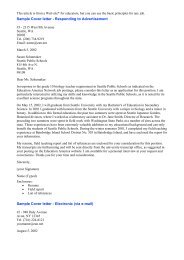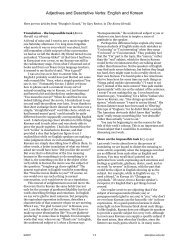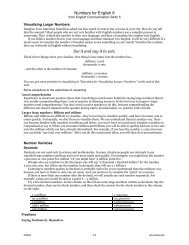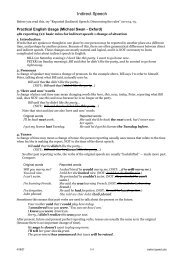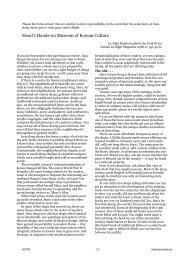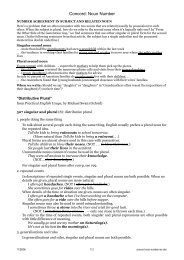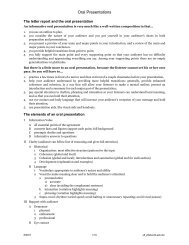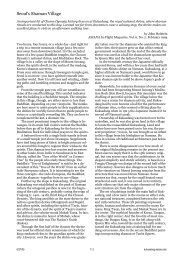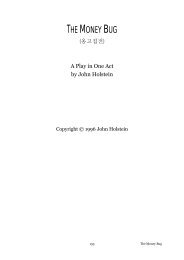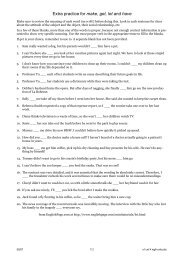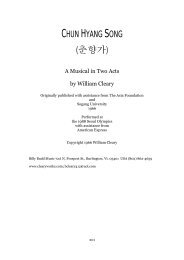The McCune-Reischauer Korean Romanization ... - Korea Mosaic
The McCune-Reischauer Korean Romanization ... - Korea Mosaic
The McCune-Reischauer Korean Romanization ... - Korea Mosaic
You also want an ePaper? Increase the reach of your titles
YUMPU automatically turns print PDFs into web optimized ePapers that Google loves.
독립문<br />
속리산<br />
강릉<br />
consonant<br />
change<br />
consonant<br />
change<br />
consonant<br />
change (also<br />
note the unrounded<br />
vowel in<br />
the second syllable)<br />
Tongnimmun Tongnimmun Doglibmun tok.lip.mun<br />
Songnisan Songnisan Sogri-san Sok.li-san<br />
Kangnûng Kangnûng Gangreung Kang.lung<br />
부부 lenis (light) stops pubu pubu bubu pupu<br />
풀 aspirate stops p’ul p’ul or pul pul phul<br />
빵 forced stops ppang ppang bbang ppang<br />
제주도 affricates Cheju-do Cheju-do Jejudo Cēycwu-to<br />
전라북도<br />
slightly rounded<br />
vowel (also note<br />
the consonant<br />
change between<br />
first and second<br />
syllables)<br />
Chôllapuk-do<br />
Chôllapuk-do<br />
or Chollapukdo<br />
Jeonlabugdo<br />
or Jeonla<br />
Bugdo<br />
Cen.la pukto<br />
금잔디 unrounded vowel kûmjandi kûmjandi geumjandi kum-canti<br />
김정호<br />
Name syllabification<br />
Kim<br />
Chôngho<br />
Kim Chông-ho<br />
or Chong-ho<br />
Gim Jeong-ho<br />
Kim Chengho<br />
Problems in the systems currently in<br />
use<br />
1) Problems common to all the romanization<br />
systems<br />
No single romanization system, transliteration<br />
or transcription, satisfactorily<br />
represents both the pronunciation<br />
and grammar of <strong><strong>Korea</strong>n</strong> because of<br />
three features of the language: the existence<br />
of sounds that cannot easily<br />
be represented by Latin letters, differences<br />
in the way <strong><strong>Korea</strong>n</strong>s and non-<br />
<strong><strong>Korea</strong>n</strong>s perceive the same sounds,<br />
and the nature of <strong><strong>Korea</strong>n</strong> orthography.<br />
Thus, because English does not have<br />
single letters that satisfactorily represent<br />
the <strong><strong>Korea</strong>n</strong> sounds for 어 and 으,<br />
we must either use a diacritic that is<br />
difficult or impossible to produce on<br />
the ordinary typewriter or computer<br />
(M-R uses the breve), or digraphs (eo<br />
or au) that are either misleading, except<br />
to initiates, or differ in pronunciation<br />
according to circumstance.<br />
Because of difference in perception of<br />
sounds, a <strong><strong>Korea</strong>n</strong> perceives the initial<br />
ㄷ in 독립문 differently from the way<br />
an American hears it, and therefore<br />
wants to transcribe it differently from<br />
the way a native English speaker<br />
does. 20 (Rector, 1999, describes this<br />
and other lenis stops as “whispered<br />
and breathy,” different from an initial<br />
English /p/ or /b/.) In addition, because<br />
<strong><strong>Korea</strong>n</strong> orthography focuses on<br />
the language’s structure, we have two<br />
basic types of romanization systems<br />
(transliteration and transcription),<br />
each with limitations, and a continuing<br />
debate over which is the best type.<br />
In a message regarding the NAKL's<br />
1999 proposal to change the official<br />
government <strong>Romanization</strong> system yet<br />
again, John Harvey 21 points out that<br />
“<strong>The</strong> real question is not so much<br />
whether the current systems [sic] has<br />
drawbacks, or even whether some<br />
other system might be better, but<br />
whether adopting any other system<br />
would be worth 1) the huge amount of<br />
money required for making the<br />
7/2/05 5/ 19 mr9912



